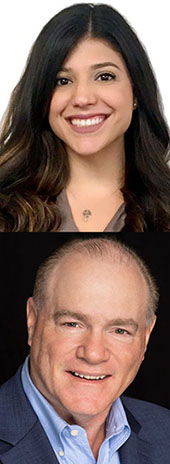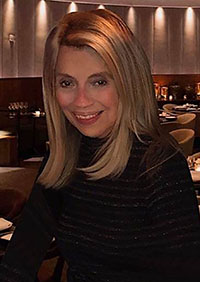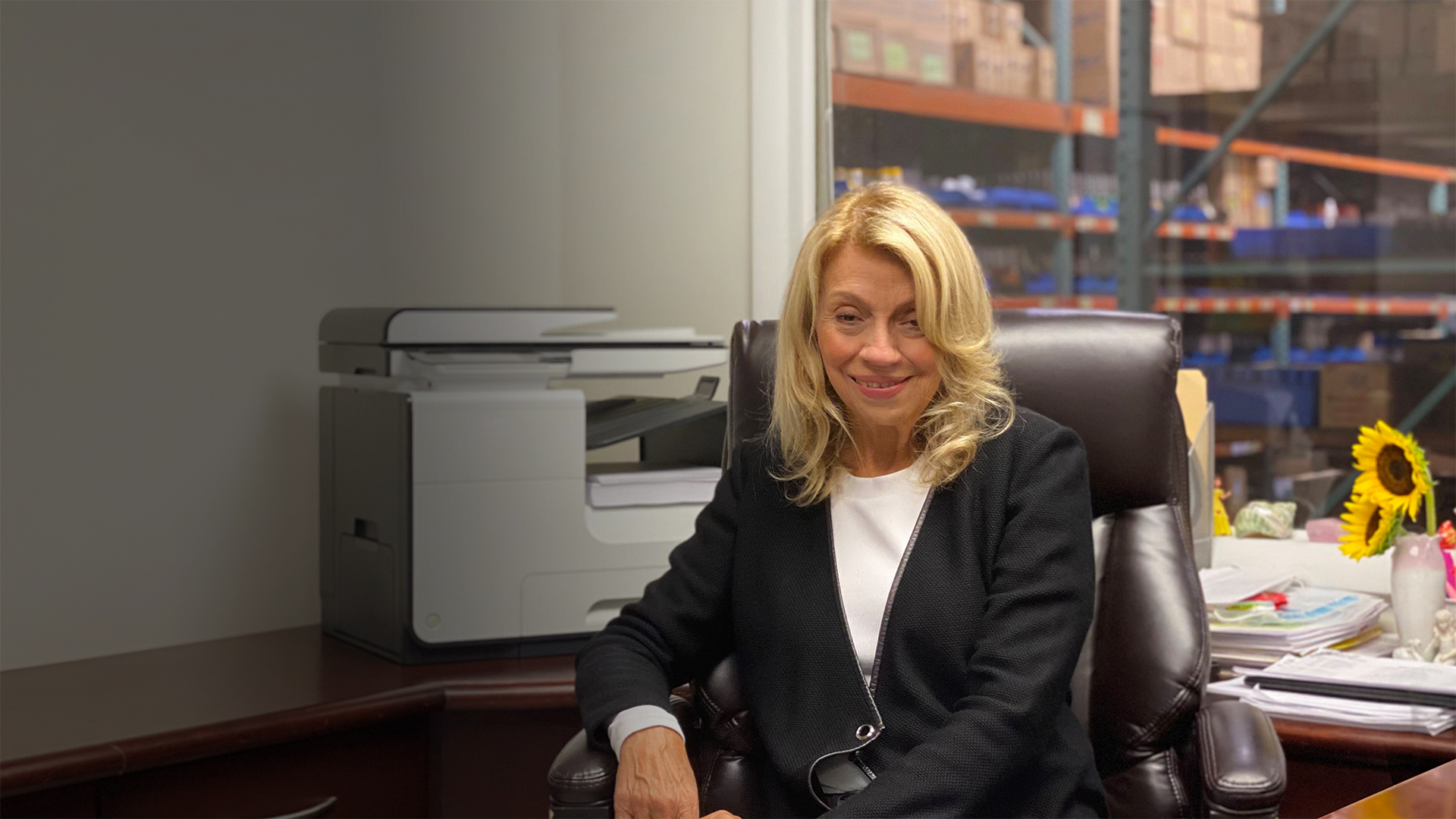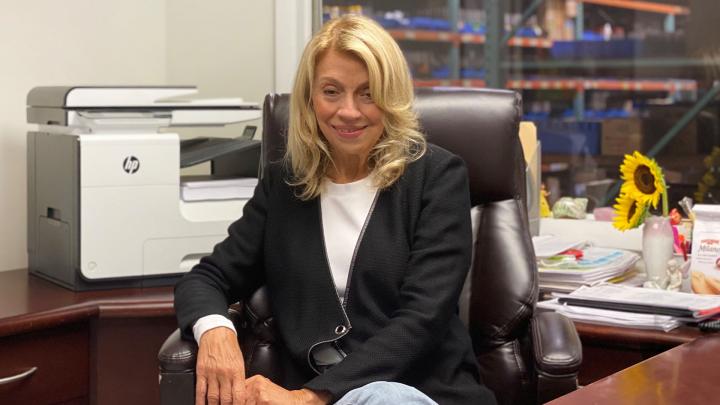Sales representative. Merchandiser. Delivery driver. Display builder. In the beginning, Natty Elias was all of the above – a one-woman show from her car.
Working to grow her nascent retail distribution business in and around Miami, she supplied Latino-owned mom-and-pop stores with lotions and fragrances from a single baby care brand, Para Mi Bebe. Then came her first big breakthrough: a handful of managers for a regional supermarket chain agreeing to give her space in their respective stores.
“Each of them allowed me to put one little display up, and I’d go in every day to straighten and clean it,” recalls Elias, who started Healthtex Distributors – then called HBA – in 1988 with the goal of getting brands and products popular with Miami’s large Cuban population into more local stores. “The managers said, ‘You have to keep this spotless and organized every day.’ Sometimes things would be on the floor, the products spilling. I was constantly replacing the cardboard displays – I’d buy them over and over again. It was all just part of my routine.”
It’s impossible to calculate just how many other routines have been maintained without interruption over the last 32 years thanks to Elias and her company – which, needless to say, is no longer nascent. Today, Healthtex supplies hundreds of fiercely loved products to about 6,000 small and large retailers throughout Florida – including Walgreens, which in turn has made some of those products available in hundreds of stores in other states.
It’s not just baby care anymore. There are health and wellness items, over-the-counter remedies and beauty supplies, not to mention cleaning products and heftier items like espresso makers and cookware – with each brand deeply important to a particular slice of the greater Florida Latino community. Some of the product lines are immensely popular among Cubans, Puerto Ricans and Dominicans – the “Caribbean Latino” demographic that comprises 80 percent or more of the population in parts of South Florida. Others brands are more culturally significant to shoppers from Central and South America, especially Venezuela, Colombia and Nicaragua.
Simply put, Healthtex is a pipeline, a conduit, allowing retailers to help their Latino customers feel more at home by offering products they know and swear by.
Those early years, though? Nothing easy about it, especially for a Latina businesswoman working solo. Elias – who’s now such a fixture in Miami’s business community that many know her simply as Natty – once met with a male Caucasian buyer who placed a timer on the table in front of her and told her she had until the clock ran out to sell him on her products. She immediately started to pack up her things.
“I told him there was no way I could possibly show him the value of these brands and their importance to the Hispanic communities in the limited time he was offering,” she says. “In those days I was often up against buyers who didn’t understand the Hispanic cultures and the diversity within the communities – just the huge influx of immigrants coming into the area. That was the biggest challenge for years – trying to get buyers to sit with me long enough to understand.”
Endless education
That particular buyer put away his timer that day and apologized, Elias says. He listened. He learned.
Time and time again, it has all come back to learning. At Walgreens, Beverly Lugo, category manager for multicultural goods, and Jeff Rubin, regional merchandise manager for South Florida, have worked closely with Elias and Healthtex for several years, although the companies’ relationship dates back to the mid-1990s. Healthtex is an official “category captain” supplier for Walgreens in Latino products, providing the sort of guidance and insight that comes with three decades of expertise.

and Jeff Rubin
“Natty is someone who knows her business, has built and developed it, and has a very strong reputation in the community,” says Rubin.
Lugo, being Latina herself, came in already understanding the cultural significance of what Healthtex offers.
“These are brands that many of our Hispanic customers grew up with, which their moms and grandmothers have used and recommend,” Lugo says. “That’s very important across all Hispanic cultures – recommendations from your family members, and brands that you trust and you know. They might be very old brands, but they’re still very relevant for these customers.”
Certain brands of baby colognes, for example, are huge among Caribbean Latino customers – the reason why Para Mi Bebe was Elias’ first brand back in the day.
“Where these colognes are carried, you may see 15 different kinds, and everyone has their favorite,” Elias says. “That was one of the hardest sells early. Some non-Hispanic buyers didn’t understand: ‘You put cologne on your children? What age do you start?’ It’s from the moment they’re born. My own kids and grandkids – those scents remind them of their childhood. They put it on their pillows. They still wear it today.”
And yet Mexicans don’t consider these fragrances as important, Elias notes. What one Latino culture adores might not matter at all in another Latino culture. In order to grow her business, Elias – whose father brought her and her mother and sister to the U.S. from Cuba in the early 1960s – had to learn all the nuances, then find the brands and educate current and potential retail partners.
“It was a matter of being in the stores, speaking to a lot of managers, seeing the people – and especially in the little mom-and-pop stores, you get a lot of information there,” she says. “And then, of course, just living in the community, you meet a lot of people from all walks. You have friends from all nationalities. You get to understand what products they’re looking for.
“As the communities grew, large retailers started realizing they had these huge pockets of customers asking for products: ‘Do you carry this? Do you carry that?’ So managers would ask me if I could get something because customers were asking for it. That’s the kind of feedback I would get. Then I’d source it while they got the product approved for their store.”
Even then, there was always much more to be learned.
“It’s not just about having the right products – you have to have the right brands,” Elias says. “It’s about the assortment, the vibrance around it, the Spanish-language signage. You’ve got to make customers feel like they’re at home, that the store gets them. ‘They have the things that I need. They understand me.’”
Old classics, new twists
The most popular item Healthtex supplies Walgreens is Dr. Sana camphor cubes for respiratory congestion, followed by Dr. Sana sodium bicarbonate powder – a heartburn remedy. But recently, something else cracked the top spots in Florida, with appeal well beyond the Latino communities. Shortly after the coronavirus pandemic began, retailers were hit by a thermometer shortage. Enter Healthtex, which already was cleared by the FDA to import medical devices and had a contact in China that manufactured high-quality thermometers.
“When we didn’t have any thermometers in our South Florida stores at the end of May and beginning of June, we were able to bring those in through Healthtex,” Rubin says. “That’s the kind of partner they are. There was a need in the community, and they came to us, and we were able to get it executed.”
Not quite as new to the Walgreens-Healthtex relationship is the introduction of a more typical “warehouse model” about six years ago. Through this arrangement, about 15 popular products supplied by Healthtex are distributed through Walgreens’ supply chain to 1,055 stores with large Latino customer bases, mostly in Florida, New York, New Jersey, California and Texas.
Within Florida, however, the classic system also still applies. Healthtex distributes hundreds of other products – including more than 500 to Walgreens – using direct store delivery, not unlike Elias’ early days when she was zipping from store to store personally. A sales rep will visit a Walgreens, usually once a week, and send orders to Healthtex’s warehouse. Truck drivers then bring the required units to stores. A Healthtex merchandiser replenishes products and cleans and maintains the shelf space.
“We really do all the work,” Elias says. “The store doesn’t have to touch it.”
Elias knows one member of this team especially well – her son, Guido, who co-oversees the operations side of the business, visiting stores the whole length of Florida to find new opportunities, check products and sections and maintain good relationships.
To be clear, this is a one-woman show no more. In fact, as Walgreens Boots Alliance works to expand its global base of female- and minority-owned suppliers over the next few years, Healthtex is a standard-bearer for both of those groups. Of 80-plus Healthtex employees, all are Latino and three-quarters are women, including the vice president, controller, sales director, head of purchasing and logistics manager.

Last October, Elias was named 2019 Hispanic Businesswoman of the Year by the South Florida Hispanic Chamber of Commerce. That same day, she also was recognized by the U.S. House of Representatives, in a floor presentation by Rep. Donna Shalala, for her work as an entrepreneur bettering the lives of residents of South Florida.
“I’ve had my share of nice surprises,” she says.
But it’s not about her, really. Has it ever been?
Her father had two philosophies that stay with her always. The first: No fear. The second: There’s no good business with bad people, and no bad business with good people.
Business with good people that also fulfills an emotional need for potentially millions of customers? Well, that’s the best business of all.
“Here at Healthtex, we’re a family and we take care of each other,” Elias says. “And we make sure we’re representing a little bit of everybody out there.”

